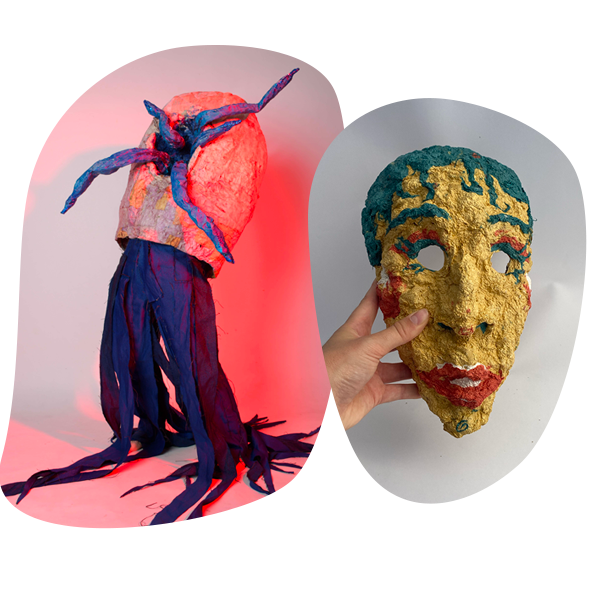Recycling Textile Waste Mask¶

| Path | Target | Duration | Skills |
|---|---|---|---|
| Curiosity | Kids 8 to 18 | 1,5 h or 4 days | Recycling, Biofabrication |
Introduction and context¶
Abstract
Recycling Textile Waste Mask is an activity that increases awareness of textile waste issues, and provides lowtech solutions and knowledge on recycling and biofabrication through play and making.
Learning through play is one of the methodologies used in kids' learning, where children invent and share their own games and DIY toys based on age, likes and interests. With Learning Through play, children can develop social and cognitive skills, mature emotionally, and gain the self-confidence required to engage in new experiences and environments (Wikipedia, 2021) Learning through making is another core methodology in the Fab Lab and makerspace environment. Martinez (2014) emphasizes that “Learning through making, both at schools and afterschool activities is contributing to the creation of a safe environment for kids to play, discover, tinker, experiment, activate their creativity and develop their fine motor skills”.
Intro
A short version of this activity can be developed in a format where the composite of textiles + alginate are prepared in advance so the young children only focus on the modeling part and create their own individual mask. The duration of this short version is 1h 30' including a short introduction to mask representation in art history.
This presentation can be used and adapt for the short activity :
For a more advanced level, like teenagers in art school, or after school program, the fabrication of a big customized sculpture can be considered, for which the use of wire frame is needed to support the creation. In this case, it is advisable to divide the activity into 3 or 4 sessions, in order to proceed with all the steps including all the preparation of the composite by the students. It’s also recommended to divide the group in small collaborative teams of 2 or 3 students working on the same project.
You can use and adapt this presentation for the advanced activity :
Objectives
The activity aims at raising awareness of textile waste issues and proposing solutions to act locally, with easy and low tech processes. The purpose of the learning activity is to produce new material from textile waste.
Learning Outcomes:
- Get an overview textile waste problem
- Generate mask design by using AI
- Be able to transform old textile with kitchen tools
- Get introduced to possible projects that can be done with recycled textile composite
Target audience and context of use
Kids, families, educators with interest in learning recycling concepts with simple tools just to learn or to apply this knowledge in the classroom in a ludic way.
This activity can be celebrated in different places like schools, art class, labs or museums. Set up a collaboration between your lab, material centers and a cultural center or museum.
The recipe can be printed and given to the participants
One instructor per 10 kids is recommended.
Materials¶
Equipment, Tools and Materials
- 2 mixers
- 2 smalls shedders
- 1 textile scissors per participants
- Large pot
- spatule
For advanced level : * Inox (important !) wireframe * Pince coupante * Pince * Shredder like Precious plastic, if possible
- Sodium Alginate
- Solution of Calcium Chloride 10%
- Water
- 1 TV or video projector to present the documentation
- 1 computer with an account to Dall-e or Midjourney (AI) and a printer to print the generated image for the kid
- Blank sheet, color pen…
- One “dirty” big table protected by a plasticized tablecloth
- Ballons, bassine, scotch
Preparation¶
STEP BY STEP overview
- You can set up a collect point in your lab, in the school, in the public space where you give the activity. Communicate long time in advance.
- You can ask a local manufacture, or even an independent seamstress to give you waste of their production, they have plenty of and most of the time they don’t know how to deal with it. It’s a great opportunity to have textile in small pieces, sorted by colors, and by composition.
- Important: for this workshop we only use natural fiber like coton, linen… Synthetic or mixed textile won’t with our recipes and would not create a biomaterial as it contain plastic fibers.
- Check you have all the tools and materials needed and that you will have time to wrap up your tools, set up the logistics for the event room.
- Be careful, buy a specific shredder and mixer, that you won’t use anymore for cooking real food. It’s also mandatory to have an access to water in the room
Presentation for the class
Short version for kids
Advanced level
Flyer for participants
Downloadables¶
| Presentation 1 | Brochure | Presentation 2 |
|---|---|---|
| Short | Brochure | Advanced |
Licence and credits¶

Attribution — ShareAlike CC BY-SA This activity has been designed by Pauline Gamore at Le Textile Lab Lyon for shemakes.eu. It is based on Fabricademy´s learning content of biofabrication materials and textile scaffold and Le Textile Lab´s learning experiences methodology.
It can be combined with the other topics of Topic/skills, within the Sustainability and Industry 4.0 Packages of Fabricademy.